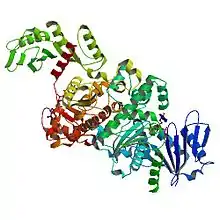Acétate kinase
L'acétate kinase est une phosphotransférase répandue chez les bactéries et les archées, qui catalyse la réaction : Acétate + ATP phosphate d'acétyle + ADP.
Acétate kinase

| N° EC | EC |
|---|---|
| N° CAS | |
| Cofacteur(s) | Magnésium |
| IUBMB | Entrée IUBMB |
|---|---|
| IntEnz | Vue IntEnz |
| BRENDA | Entrée BRENDA |
| KEGG | Entrée KEGG |
| MetaCyc | Voie métabolique |
| PRIAM | Profil |
| PDB | RCSB PDB PDBe PDBj PDBsum |
| GO | AmiGO / EGO |
Elle utilise le cation magnésium Mg2+ comme cofacteur[2],[3].
L'acétate kinase intervient dans la glycolyse en cas d'excès de glucose, ainsi que dans la méthanogenèse pour convertir l'acétate en acétyl-CoA avec la phosphate acétyltransférase.
Notes et références
- (en) Kathryn A. Buss, David R. Cooper, Cheryl Ingram-Smith, James G. Ferry, David Avram Sanders et Miriam S. Hasson, « Urkinase: Structure of Acetate Kinase, a Member of the ASKHA Superfamily of Phosphotransferases », Journal of bacteriology, vol. 183, no 2, , p. 680-686 (lire en ligne) DOI:10.1128/JB.183.2.680-686.2001
- (en) F. J. Grundy, D. A. Waters, S. H. Allen et T. M. Henkin, « Regulation of the Bacillus subtilis acetate kinase gene by CcpA », Journal of Bacteriology, vol. 175, no 22, , p. 7348-7355 (lire en ligne)
- (en) John D. Oultram, lan D. Burr, Michael J. Elmore et Nigel P. Minton, « Cloning and sequence analysis of the genes encoding phosphotransbutyrylase and butyrate kinase from Clostridium acetobutylicum NCIMB 8052 », Gene, vol. 131, no 1, , p. 107-112 (lire en ligne) DOI:10.1016/0378-1119(93)90677-U
- Portail de la biochimie
Cet article est issu de Wikipedia. Le texte est sous licence Creative Commons - Attribution - Partage dans les Mêmes. Des conditions supplémentaires peuvent s'appliquer aux fichiers multimédias.